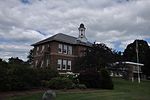Dean Memorial Airport
Airports in New HampshireHaverhill, New HampshireTransportation buildings and structures in Grafton County, New Hampshire
Dean Memorial Airport is a public use airport in Grafton County, New Hampshire, United States. It is owned by the town of Haverhill and is located three nautical miles (5.56 km) northeast of the central business district. It is included in the Federal Aviation Administration (FAA) National Plan of Integrated Airport Systems for 2017–2021, in which it is categorized as a basic general aviation facility.Although most U.S. airports use the same three-letter location identifier for the FAA and IATA, this airport is assigned 5B9 by the FAA but has no designation from the IATA.
Excerpt from the Wikipedia article Dean Memorial Airport (License: CC BY-SA 3.0, Authors).Dean Memorial Airport
Airport Road,
Geographical coordinates (GPS) Address Website External links Nearby Places Show on map
Geographical coordinates (GPS)
| Latitude | Longitude |
|---|---|
| N 44.080172222222 ° | E -72.007761111111 ° |
Address
Dean Memorial Airport
Airport Road
03774
New Hampshire, United States
Open on Google Maps









